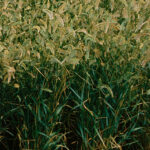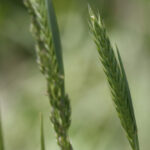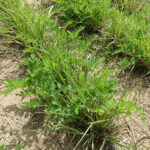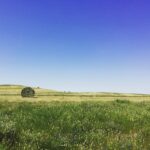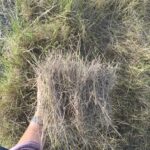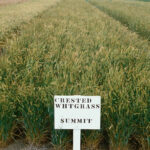Crested Wheatgrass
Agropyron cristatum
General Description
Crested wheatgrass is a hardy perennial, bunchgrass with fibrous roots. There are two crested wheatgrass species. Diploid types (A. cristatum, Fairway-Parkway types) have smaller seeds, finer leaves and stems, and are slightly less drought tolerant than the tetraploid types (A. desertorum, Nordan/Summit). Some cultivars are also intermediate, being derived from hybrids.
Stems are erect 50 to 100 cm (20 to 39 in) tall or more, and usually softly hairy below the spike. Crested wheatgrass leaves are green to slightly blue-green with rough margins and upper surface veining. The blades are flat, 1.5 to 6 mm wide and softly hairy on the upper surfaces. The flat, comb-like seed heads or spikes are very distinctive. The spikes are up to 7 cm (3 in) long and 2.5 cm (1 in) wide, with a dense, oblong, flattened shape.
Type
Tame grass.
Origin
Siberia. Varieties developed in Canada.
Longevity
At least 20 years in dry soil zones. It does not persist as long in the higher precipitation soil zones, the Peace River Region, or the central interior of British Columbia.
Use
Pasture, hay. Most often used for early spring pastures as it is noted as the first grass to green in the spring. Tetraploid types tend to be more upright so are better suited for hay production. Crested wheatgrass was used extensively in historic rehabilitation efforts on western rangelands, however its invasive nature makes it unsuitable for modern restoration efforts.
Optimal Time of Use
Spring, summer. Crested wheatgrass is best known for its very early spring growth. Crested wheatgrass can be continually or rotationally grazed. Graze to keep from heading to maintain palatability. Crested wheatgrass is ready to harvest early – cut at heading for best quality.
Recovery After Use
Requires a minimum 60-80 days of recovery after use. Crested wheatgrass produces good forage in early spring but requires additional moisture and rest for regrowth. Crested wheatgrass has a high tolerance for close grazing.
Palatability/Nutritional Value
Crested wheatgrass provides palatable, productive, and nutritious forage in May and June. It is most palatable to all classes of livestock before heading. Crested wheatgrass has an average digestibility of 61% and crude protein level of 11-12% when vegetative. Palatability declines rapidly as it matures. Fall green up in years with late season moisture can improve palatability for late season grazing.
Annual Precipitation min/max (mm)
200mm / 760mm
Drought Tolerance
Excellent tolerance. After drought, crested wheatgrass is slow to resume growing during the growing season.
Flooding Tolerance
Can withstands 1-2 weeks of spring flooding. Poor tolerance to excessive soil moisture.
Winter Hardiness
Excellent hardiness. One of the most cold-hardy forage grasses on the Canadian Prairies.
Soil Texture Preference
Adapted to well drained sandy to clay soils. Suited to both fertile and poor soils.
Erosion Control
Effective erosion control. Crested wheatgrass has value for erosion control on semi-arid sites where species choices are limited. It will self seed and fill in an area.
Salinity Tolerance
Moderate tolerance.
Acidity Tolerance
Slight tolerance.
Alkalinity Tolerance
Moderate to high tolerance.
Seeds per kg
428,000 seeds/kg (194,000 seeds/lb)
Suggested Mixtures
Mix with a legume such as alfalfa or sainfoin or a grass such as hybrid bromegrass to increase forage yield and overall quality where precipitation permits. Select a crested wheatgrass variety based on the additional characteristics desired of the stand.
Ease of Establishment
Crested wheatgrass establishes quickly when conditions are suitable (cool, moist) and establishes satisfactorily if conditions are not ideal. Wait to utilize until the year after seeding.
Competitiveness
Seedlings can be vigorous but are sensitive to competition. Once established, crested wheatgrass is very competitive and will self seed. Crested wheatgrass can resist competition from downy brome better than other grasses. Invasion of crested wheatgrass into native grasslands is problematic in Alberta and Saskatchewan.
Management Considerations
Established stands can be heavily used without reducing the long term yield. Manage grazing and/or haying to keep crested wheatgrass vegetative, reduce mature plants, and manage the risk of invasion into adjacent areas (native prairie, fields).
British Columbia Rangeland Seeding Manual, Saskatchewan Dryland Forage Species Adaptation Tool, USDA Plants Database, Manitoba Forage Adaptation and Comparison Guide, Alberta Forage Manual
Crested wheatgrass is adapted to dry or drought-prone sites in the Sub-Boreal Spruce and the Sub-Boreal Pine-Spruce. Longevity and persistance in a stand may be reduced in wetter areas in these zones where other species may be more competitive. Crested wheatgrass is adapted to the semi-arid parts of the Bunchgrass zone and the dry parts of the Interior Douglas-fir zone in the southern part of the Central Interior.
Crested wheatgrass is adapted to the semi-arid parts of the Bunchgrass zone, the Ponderosa Pine zone and in the dry parts of the Interior Douglas-fir zone.
Crested wheatgrass is winter-hardy, and may be a suitable choice on drought prone sites with southern exposure in the Peace-Liard region. Persistence in a stand is likely to be related to moisture availability. Where moisture is more available, other species may be more competitive, and crested wheatgrass may be less persistant.
